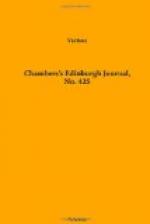one depicting some miracle, in which several grave
ecclesiastics are seen swimming about in the Grand
Canal, while ladies look on from windows and balconies,
which I convinced myself still exist there. I
must be equally brief with that place which no countryman
of Shakspeare can avoid visiting, though the present
Rialto is, after all, later than his time. It
is of a curious structure as a bridge; there being
three rows of building along it, containing shops,
with two roadways for passengers. One crosses
backwards and forwards, muttering: ‘On
the Rialto thou hast rated me,’ &c.; goes distractedly
into a shop, to purchase a breastpin, as a memorial
of the place; and then plunges down the stairs, to
resume his place in the gondola. We took a couple
of hours to pay a visit to the Armenian monastery,
on the island of San Lazzaro—the place
to which Byron resorted in order to study the Armenian
language. It is a curious old establishment,
with some modern activity about it in the diffusion
of literature; the monks having a printing-office
in tolerable briskness, whence they issue books in
various languages. We were delighted with the
flush of beautiful flowering, from the oleander bushes
in the central court, and the vine-hung alleys in
the garden behind. I must not forget, in this
hurried close of my adventure, the two moonlight sails
we had through those mysterious watery streets, where,
the associations of day and of the active world being
shut out, we felt as if each light in the old palazzi
illumined some scene of mediæval romance. That
was like no other thing in our lives. On the third
evening, we left this dream-city by a means which
we had studiously ignored all the time of our visit—namely,
a railway, which crosses from Venice to the
mainland. It was something of a wakener to find
ourselves at ’the station,’ on the bank
of one of the canals, and see a range of ‘omnibus
gondolas,’ all duly labelled for their respective
courses through the city, and ranked up in front like
so many of the terrestrial machines which haunt the
ordinary railway termini of this earth. However,
we had the consolation of reserving this to the close
of our visit, when, of course, we must have awaked
out of our Venetian feelings at anyrate. The
train brought us to Padua long before bedtime.
REALLY! INDEED! IMPOSSIBLE!
During a prolonged summer sojourn with kind friends resident in a quiet country town, we became quite interested in the tactics of the neighbours, and acquainted with their social condition.
‘I think we have almost exhausted our visiting round,’ said our hostess, Mrs Smith, one morning, as she replenished her card-case, ’with the exception of Really, Indeed, and Impossible, to whom we must introduce you. You look puzzled! but I mean the three Misses Bonderlay, who are usually distinguished by these interjectional names. We will forthwith send them an invitation to tea this very evening, and they shall be their own etymologists.’




